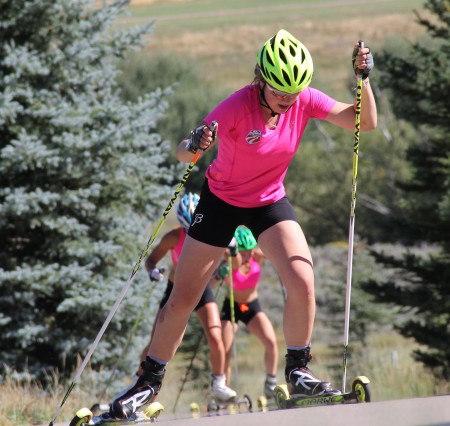
16 of America’s best junior skiers descended on Park City, Utah, to participate in the week-long U20 National Training Group Camp August 13. In its second year, the camp serves as an opportunity for junior skiers to develop a strong, national training group at a relatively young age.
To be nominated for the National Training Group (NTG), U20 athletes must have either qualified for Junior World Championships or Youth Olympic Games, garnered a top women’s top-10 or a men’s top-15 at the U18 Nation’s Cup (formerly known as the J1 Scando Cup), or earned a podium finish in the U18 category or won the U20 category at the Junior Olympics.
Once nominated athletes must attend the U20 NTG Camp, compete in U.S. Nationals, and race internationally for at least two weeks to become part of the National Training Group.

According to Bryan Fish, the U.S. Ski Team Development Coach, earning a spot on the in the NTG serves athletes well especially when it comes to international racing, Building a strong team environment can make international traveling and racing much easier, and thus more successful, Fish said.
“They can lean on one another when in a foreign venue,” he wrote in an email.
As a requirement for the NTG, the U20 camp serves many purposes.
According to Fish, the most important aspect of the camp is the development of a group that can push themselves in both training and competition. The coaches of the camp, including U.S. Ski Team women’s coach Matt Whitcomb, men’s coach Jason Cork, and Fish, attempt to create a productive training environment where athletes can learn from one another.
While much of the training at the camp includes technique and agility exercises, the U20 athletes also have the opportunity to take advantage of the many U.S. Ski Team resources.
Participants have access to the U.S. Ski Team’s Sport Science Staff, which includes a strength coach, nutritionist and chef, and a performance psychologist.
In addition, the camp provides testing for athletes so that they can improve their training in specific areas for the rest of the summer and fall.
The tests include:
– Classic max tests on the Center of Excellence’s ski treadmills to review fitness and technique
– Hemoglobin mass tests which serve as a back-up test to our treadmill test and also provides information as to whether an athlete may be low in iron
– Functional Movement Screenings which identifies at limitations on range of motion or asymmetry in athletes
– Strength test looking at power output from both sides of the body.
According to Fish, the tests are only small part of an athlete’s training.
“Nothing substitutes a training routine that is high in quality and consistency throughout the year,” he wrote. “That being said, the athletes and their coaches receive suggestions based on the testing results as to where they may target their individual training.”
The U20 NTG Camp concludes August 20, and Fish believes the experience will provide a strong base for the athletes in attendance but also for the future of the sport in the country as well.
“One camp is not going to make or break the success of an individual athlete, however these camps have a compounding effect,” Fish said. “Every one of these athletes has been to multiple regional and national development camps already in their career. A blend of consistent local club training with occasional camps creates a motivating environment to stimulate positive growth in their performance.”
2014 U20 National Training Group Camp Participants

Men
Cole Morgan
Jack Hegman
Thomas O’Harra
Lars Hannah
Max Donaldson
Gavin McEwen
Zak Ketterson
Women
Katharine Ogden
Mattie Watts
Heidi Halvorsen – injured
Vivian Hett
Julia Kern
Aja Starkey
Gretchen Burkholder
Hailey Swirbul
Marion Woods
Hannah Halvorsen
Lander Karath
Lander Karath is FasterSkier's Associate Editor from Bozeman, Montana and a Bridger Ski Foundation alumnus. Between his studies at Middlebury College in Vermont, he is an outdoor enthusiast and a political junkie.



